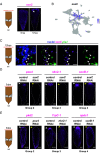A wound-induced differentiation trajectory for neurons
- PMID: 38976727
- PMCID: PMC11260127
- DOI: 10.1073/pnas.2322864121
A wound-induced differentiation trajectory for neurons
Abstract
Animals capable of whole-body regeneration can replace any missing cell type and regenerate fully functional new organs, including new brains, de novo. The regeneration of a new brain requires the formation of diverse neural cell types and their assembly into an organized structure with correctly wired circuits. Recent work in various regenerative animals has revealed transcriptional programs required for the differentiation of distinct neural subpopulations, however, how these transcriptional programs are initiated in response to injury remains unknown. Here, we focused on the highly regenerative acoel worm, Hofstenia miamia, to study wound-induced transcriptional regulatory events that lead to the production of neurons and subsequently a functional brain. Footprinting analysis using chromatin accessibility data on a chromosome-scale genome assembly revealed that binding sites for the Nuclear Factor Y (NFY) transcription factor complex were significantly bound during regeneration, showing a dynamic increase in binding within one hour upon amputation specifically in tail fragments, which will regenerate a new brain. Strikingly, NFY targets were highly enriched for genes with neuronal function. Single-cell transcriptome analysis combined with functional studies identified soxC+ stem cells as a putative progenitor population for multiple neural subtypes. Further, we found that wound-induced soxC expression is likely under direct transcriptional control by NFY, uncovering a mechanism for the initiation of a neural differentiation pathway by early wound-induced binding of a transcriptional regulator.
Keywords: functional genomics; neural differentiation; regeneration; stem cells; wound response.
Conflict of interest statement
Competing interests statement:The authors declare no competing interest.
Figures





Update of
-
A wound-induced differentiation trajectory for neurons.bioRxiv [Preprint]. 2023 May 11:2023.05.10.540286. doi: 10.1101/2023.05.10.540286. bioRxiv. 2023. Update in: Proc Natl Acad Sci U S A. 2024 Jul 16;121(29):e2322864121. doi: 10.1073/pnas.2322864121. PMID: 37214981 Free PMC article. Updated. Preprint.
References
-
- Bely A. E., Nyberg K. G., Evolution of animal regeneration: Re-emergence of a field. Trends Ecol. Evol. 25, 161–170 (2010). - PubMed
-
- Lai A. G., Aboobaker A. A., EvoRegen in animals: Time to uncover deep conservation or convergence of adult stem cell evolution and regenerative processes. Dev. Biol. 433, 118–131 (2018). - PubMed
-
- Thor S., Andersson S. G. E., Tomlinson A., Thomas J. B., A LIM-homeodomain combinatorial code for motor-neuron pathway selection. Nature 397, 76 (1999). - PubMed
-
- Melkman T., Regulation of chemosensory and GABAergic motor neuron development by the C. elegans Aristaless/Arx homolog alr-1. Development 132, 1935–1949 (2005). - PubMed
MeSH terms
Grants and funding
- F31 GM134633/GM/NIGMS NIH HHS/United States
- R35 GM128817/GM/NIGMS NIH HHS/United States
- R35 GM153252/GM/NIGMS NIH HHS/United States
- 1F31GM134633-01A1/HHS | NIH | National Institute of General Medical Sciences (NIGMS)
- 2020296625/NSF | National Science Foundation Graduate Research Fellowship Program (GRFP)
LinkOut - more resources
Full Text Sources

